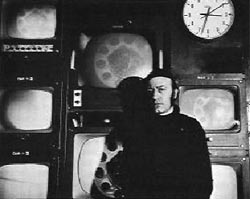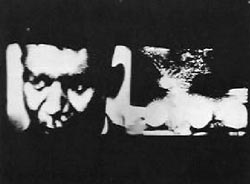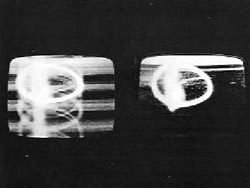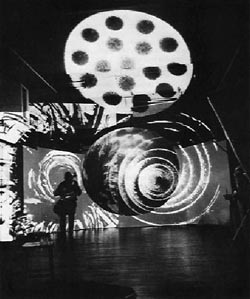[ index | 1968 ]
aldo tambellini
"Our creative involvement with television must begin now so that the electronic energy of communication can give birth to new visions: we will face the realities which astronauts and scientists know to be part of life."
Intermedia artist and filmmaker Aldo Tambellini has worked creatively with television in many ways for several years. He has produced synaesthetic videotapes, videographic films, and closedcircuit teledynamic environments. All of his work, in whatever medium, is concerned with the theme of "black," both as idea and experience. For Tambellini, black is the womb and the cosmos, the color of skin and the color of the new consciousness. "Black is the beginning," he says. "It is birth, the oneness of all, the expansion of consciousness in all directions."

Aldo Tambellini in control room of WGBH-TV, Boston.
Tambellini began working with videotape in 1966-67 as part of his intermedia presentations. This work was subsequently expanded into live, closed-circuit, and broadcast video experiments. In the spring of 1969, Tambellini became the recipient of a grant from the New York State Council on the Arts in a project to develop relationships between artists and television engineers. He worked with technologists at five educational TV stations throughout New York, producing several experimental programs.
Also in 1969 he was one of six artists participating in the PBL program "The Medium Is the Medium" at WGBH-TV in Boston. The videotape produced for the project, called Black, involved one thousand slides, seven 16mm. film projections, thirty black children, and three live TV cameras that taped the interplay of sound and image. The black-and-white tape is extremely dense in kinetic and synaesthetic information, assaulting the senses in a subliminal barrage of sight and sound events. The slides and films were projected on and around the children in the studio, creating an overwhelming sense of the black man's life in contemporary America. Images from all three cameras were superimposed on one tape, resulting in a multidimensional presentation of an ethnological attitude. There was a strong sense of furious energy, both Tambellini's and the blacks', communicated through the space/time manipulations of the medium.

A scene from Black (1969), an experimental videotape produced at WGBH-TV with 1'000 slides, seven 16mm projectors, thirty black children and three TV cameras.
Black TV is the title of Tambellini's best-known videographic film, which is part of a large intermedia project about American television. Compiled from filmed television news programs and personal experimental videotapes, Black TV has been seen in many versions during the four-year period in which Tambellini constantly re-edited it (1964-68). "Since my interest is in multimedia and mixed-media live events, and in experimental television, I think of film as a material to work with, part of the communications media rather than an end in itself. In the future we will be communicating through electronically transmitted images; Black TV is about the future, the contemporary American, the media, the injustice, the witnessing of events, and the expansion of the senses. The act of communication and the experience is the essential."

Black TV. 1964-68. 16mm. Black and white. 9 min. Two years of TV news compressed into a staccato barrage of sight and sound.
As Tambellini's remarks indicate, Black TV is about perception in the intermedia network. It generates a pervasive atmosphere of the process-level perception by which most of us experience the contemporary environment. Since it involves the use of multiple monitors and various levels of video distortion, there is a sense of the massive simultaneity inherent in the nature of electronic media communication. Black TV is one of the first aesthetic statements on the subject of the intermedia network as nature, possibly the only such statement in film form.

Black Video Two. 1968. VTR. Black and white. Both image and sound were generated electronically. Made in collaboration with engineer Ken Wise.
Black Video One and Two are representative of the techniques and approaches involved in Tambellini's videotape compositions. He calls them "video constructions" to emphasize that they are self-contained image- and sound-generating units, which do not take image material either from broadcast programs or closed-circuit cameras. Instead, special circuitry is devised to generate both image and sound electronically on two monitors. These completely synthetic videographics can be juxtaposed with other image material to create a sense of convergence between different worlds. As in most of Tambellini's work, archetypal white globes, spheres, or expanding coils are seen suspended in a black video void. Various forms of video noise are generated to accentuate the purely kinetic aspect of the tapes. Most of this work was first produced in 1967-68, and has been incorporated into Tambellini's intermedia presentations and films.
Black Video Two was exhibited at the Howard Wise Gallery in New York in 1967. Two years later, Wise commissioned Tambellini and two engineers from Bell Telephone Laboratories to produce a work for his exhibit "Television as a Creative Medium." Tambellini and the engineers, Tracy Kinsel and Hank Reinhold, came up with Black Spiral, a beautiful example of aesthetically manipulated video circuitry. The normal rectangular raster of the TV picture was transformed into a circular raster by modification of the circuitry from an xy coordinate system to a polar coordinate system. As a result, the broadcast picture appeared as a flowing spiral; any movement in the picture caused the spiral to swoop and explode in giant gaseous curls of glowing phosphors. "Television is not an object," Tambellini said. "It's a live communication media. Black Spiral brings you live information. One day we will look at nature as the floating astronauts do in a spiral or circular form where no up or down or gravity exists." The sound was transformed by modulating normal audio signals from the television station with a random audio signal.
"The artist will have to get to this medium and begin to explore all possibilities," Tambellini urges. "After all, television is actually an image made of light which travels through time and space. I'm interested in getting to that particular point to actually show that light is a constantly moving and ever-changing form, that light is energy, and the same energy which moves through us is the energy which moves through the universe. It is the same energy we have discovered in the atom. When creative people begin to get involved with this idea of energy rather than making objects for someone, they will be exploring possibilities for everybody, art will be an exploration for all of mankind."
-- Gene Youngblood: EXPANDED CINEMA, 1970, [PDF /4.6 Mb] pp. 308-314.
---
Aldo Tambellini: Electromedia Theatre
A pioneer in intermedia techniques, Aldo Tambellini has worked with multiple projections in theatrical contexts since 1963, always striving to cast off conventional forms, using space, light, and sound environmentally. In the spring of 1967 he founded The Black Gate, New York's first theatre devoted exclusively to what Tambellini calls "electromedia" environments.
His archetype, fully realized in Black Zero (1965), is a maelstrom of audio-visual events from which slowly evolves a centering or zeroing in on a primal image, represented in Black Zero by a giant black balloon that appears from nothing, expands, and finally explodes with a simultaneous crescendo of light and sound. Literally hundreds of hand-painted films and slides are used, each one a variation on the Black Zero theme. In addition to electronic-tape compositions, the piece often is performed in conjunction with a live recital of amplified cello music.

Black Zero. 1965. Shown at the artists' Black Gate Electromedia Theatre in New York.
In Moon-Dial (1966) he collaborated with dancer Beverly Schmidt in a mixture of the human form with electronic imagery in slides, films, and sounds. With Otto Piene, he presented Black Gate Cologne at WDR-TV in Germany in 1968, which combined a closed-circuit teledynamic environment with multi-channel sound and multiple-projection films and slides as the participating audience interacted with Piene's polyethylene tubing. Another version of this piece was conducted along the banks of the Rhine in Düsseldorf, with projections on a mile-long section of tubing.